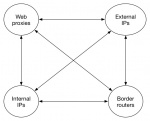Projects:2016s1-131 ECG Enhancement with Advanced Signal Processing
Contents
Topic
ECG Enhancement with Advanced Signal Processing
Supervisors
Dr. Brian Ng
Prof. Mathias Baumert
Team Members
Yang Lin
Yingtong Guo
Introduction
The electrocardiogram (ECG) recording plays an important role in medical applications. However, it is easily affected by sources [2]. In this project, we are intend to enhance ECG signals by using recent advances in digital signal processing which is based on the sparsity –based signal processing. Three ECG databases and one optional database are used to implement the approach. Generally, the desired ECG recordings are gained from websites and then according to different ECG signals, the sparsity-based method is used with different parameters. After that, the performance of the method is evaluated by comparing the accuracy of the RR interval measurements, obtained from the Pan Tompkins QRS detection algorithm.
Motivation
The ECG signals are measured from the body surface so it is easy to be contaminated by body and instruments. It is essential for doctors to diagnose the diseases accurately by analysis of ECG signals and actually, all the waves of ECG signals have a certain pattern which have a predictable time duration, a range of acceptable amplitudes and a typical morphology which means that any deviation from the normal pattern is potentially not healthy [1]. Therefore, the noise or artefacts in the ECG signals can influence the doctors’ diagnosis and that noise in the ECG ideally should be removed before doctors’ diagnosis. That is the reason why we need ECG signal processing. In this project, the noise in the ECG signals will be removed or reduced and ECG will be enhanced with digital signal processing techniques so the doctor can analyze the real signal which should make the diagnosis more accurate, stable and reliable.
Previous Studies
This project is not a follow-up project but it is based on the work of Ning and Selesnick [2]. In their paper, some detailed denosing problem and proposed algorithm has been discussed. The most important thing is that the sparsity-based method has been introduced which make it possible to implement in ECG signals [2]. In addition to that, the QRS detection algorithm is named Pan Tompkins [3] which is reliable to detect the QRS complexes. It has a good result for the standard 24h MIT/BIH arrhythmia database so it can be used to test our project’s result. In this project, three databases and one optional database are chosen from physionet website to verify the sparsity-based method in the work of Ning and Selesnick and use Pan Tompkins QRS detection algorithm to check the result.
Objectives
The aim of this project is to improve the ECG signals in three databases and one optional database. The objectives are: • Reduce the influence of noise which mainly focus on motion artefacts on ECG signal in the chosen database to provide better result for doctors. • Investigate sparsity-based separation methods for QRS detection and compare the result to previous research. • For the optional database, separate desired clean ECG signal from mixed ECG recording.
